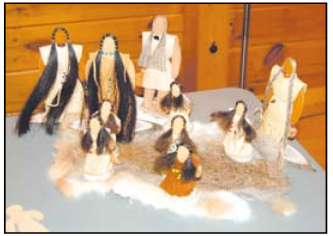I wanted to do a blog series on the history of puppets in the United States. While searching for information, I discovered that puppetry has been around a lot longer than I thought. Puppetry used by the Native American Nations is fascinating.
These various Nations utilized puppets for centuries. The puppet got its start in religious ceremonies. A variety of ritual figures used by the Native American peoples of the United States have been found. Some of these objects have movable joints and were operated by strings.
Finding detailed information and pictures is challenging since there aren’t any written records until the late 1800’s due to the western expansion. Almost all the records are by Europeans and they didn’t fully appreciate Native American culture. Therefore it was either banned, ridiculed or discounted.
Also, the puppets were used for religious ceremonies and were probably considered sacred and secret. Adding to the challenge is that there is a difference of opinion among experts about what constitutes a “puppet” as opposed to a “dance object” or even a doll. There are only a few objects collected that might fit the category of a puppet.
Based on the information I was able to uncover the Native American Nations that historians could definitely identify as using a form of puppetry are:
- The Sioux, Menominee and Ojibwe of the plains and woodlands of northern United States
- The Yup’ik speakers of Western Alaska in the Arctic
- The Hopi of southwest United States
- The Yakutat Tlingit Tribe of the Pacific Northwest
Sioux and Menominee
Ojibwe
The Ojibwe are the most populous tribe in North America living in both the United States and Canada. They occupy land around the entire Great Lakes, including Minnesota, North Dakota, Wisconsin, Michigan, and Ontario. The Ojibwe had “juggler” dolls. We don’t know exactly what they looked like but perhaps they were similar to “faceless dolls.”
Many Native cultures have a tradition of the faceless doll. In Ojibwe, the faceless doll is called Odaminwaagan and it is based on a traditional Ojibwe story (and helps facilitate stories) founded in the Ojibwe Seven Teachings. Possibly the faceless doll could be considered a puppet since it was used to help tell the stories. The picture below is a display of faceless dolls made by Joyce LaPorte, Giiwedanangikwe (North Star woman), an Ojibwe elder from the Fond du Lac reservation in northern Minnesota. LaPorte learned how to make these dolls from her Grandmother when she was five years old . Her Grandmother learned how to make them from her Grandmother. And so on back in time.

Back in 2008, LaPorte’s dolls could be seen at the National Museum of the American Indian, the Minnesota Historical Society in St. Paul, the Madeleine Island Museum, and the Fond du Lac Tribal Center. I couldn’t find any information as to whether LaPorte is still making faceless dolls.
Odaminwaagan – the Ojibwe faceless doll
While doing research for this series I discovered artist and fashion designer Carrie Moran McCleary (Little Shell Tribe of Chippewa Indians), who lives on the Crow Reservation in south-central Montana, in a January 2021 article in The Tribal Business News. She is the owner of the Plains Soul brand and has started creating faceless dolls called the Fierce Ones which can be seen and purchased at her website.
I discovered a January 2021 article in The Tribal Business News talking about artist and fashion designer Carrie Moran McCleary. She is from the Little Shell Tribe of Chippewa Indians living on the Crow Reservation in south-central Montana. She is the owner of the Plains Soul brand and has started creating faceless dolls called the Fierce Ones which can be seen and purchased at her website.
I was curious as to why the dolls were called faceless dolls. Moran McCleary relates what her mother told her when she was a child when she asked why the dolls didn’t have faces. “When you’re playing with your doll, you know how she feels, if she’s happy or sad.”
The following is a quote written by Denise E Lindquist from an article about a year ago in humanity. She is Anishinabe, the Ojibwe word for the people.
“The story goes that the doll was admiring herself in the water and was given a warning about vanity, feeling like she was better than others. Another time she was admiring herself in the lake and a bird swooped down and took her reflection. This faceless doll is a reminder to not put yourself above another and to honor the seven-grandfather teaching of humility. There is probably a name in Ojibwe for the faceless doll but I don’t know it and it really doesn’t matter as often times the people who receive a doll, name the doll.”
Sources: World Encyclopedia of Puppetry Arts
